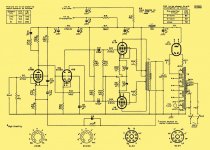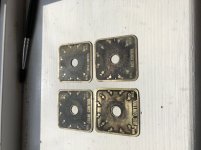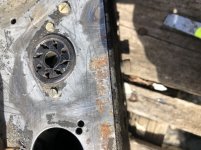I was given this valve amplifier, and upon receiving it I had a look around it for a brand, or a model name, but I couldn’t find anything. It has a pair of metal 6l6s in push pull configuration, two az31 rectifier tubes, an Ef37a and a metal 6sc7.
It has two microphone inputs and a gramaphone input, leading me to believe it is a pa amplifier, but it would be nice to find out who made it and get a few schematics. Any help is greatly appreciated, thanks very much.
It has two microphone inputs and a gramaphone input, leading me to believe it is a pa amplifier, but it would be nice to find out who made it and get a few schematics. Any help is greatly appreciated, thanks very much.
Attachments
-
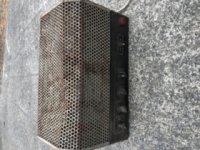 0AFAB76E-A5CC-4F84-B74E-D20E35A07BDE.jpeg40.4 KB · Views: 449
0AFAB76E-A5CC-4F84-B74E-D20E35A07BDE.jpeg40.4 KB · Views: 449 -
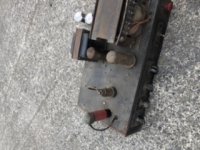 B28C29C2-C057-4590-B9BD-EF9980F56E09.jpeg35.7 KB · Views: 449
B28C29C2-C057-4590-B9BD-EF9980F56E09.jpeg35.7 KB · Views: 449 -
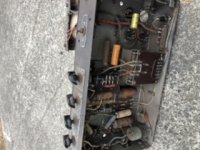 F73086C5-25AE-4A82-A6CC-7B9F40FED286.jpeg36.2 KB · Views: 448
F73086C5-25AE-4A82-A6CC-7B9F40FED286.jpeg36.2 KB · Views: 448 -
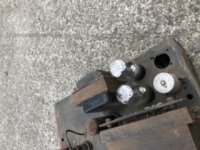 CA3F5439-A041-421F-9903-C3DFDB3B495A.jpeg36.1 KB · Views: 445
CA3F5439-A041-421F-9903-C3DFDB3B495A.jpeg36.1 KB · Views: 445 -
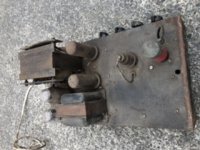 B4AEEA4F-F64B-4FA9-BEFB-C962616A5F1C.jpeg34.7 KB · Views: 433
B4AEEA4F-F64B-4FA9-BEFB-C962616A5F1C.jpeg34.7 KB · Views: 433
Thanks very much for the information, there is a inked stamp inside that says hlr, wondering if this has any indication of the make?
My apologies, I have made a mistake with on of the tube names, the tube I called a 6sc7, is actually a metal 6j7 from ken-rad. Hope this hasn’t caused any confusion.
All the best.
All the best.
Last edited:
Thanks for the information, upon inspection of the inside of the amplifier, I found what appeared to look like two more transformers, the first was a filter choke on the b+, while the second seemed to be the phase splitting transformer. Never had an amplifier like this one, it will be interesting to see what kind of sound it produces if I can get some new caps and resistors into it.
I have a few unbranded amplifiers of this kind on my collection. Maybe your amplifier does have a similar history. I've found them a prime candidate for restoration because they can be sourced cheapily and the end result is usually good. They were expensive items installed on commercial venues. The civilian industrial production took a few years to restart after WWII, at least in Europe. In second half of the '40, some installers grabbed the opportunity to sell custom systems, usually with a service contract. Being a custom device, it was somewhat shielded from competitors.
The amplifier was custom built with minor modifications from a proven design pulled from a USA magazine or supplied by the transformer manufacturer. Most parts were still designed or built before the war. This explains why the amplifier is technically ancient, altough some of them were built as late as 1950. The major design goal was reliability: a phase splitter transformer was more realiable than a tube, and you may find further redundancy such as multiple filter capacitors with smaller value instead of a single big one.
Back to your first question, they may sound surprisingly well. 10KHz top end was the standard, but on some of my specimens the bandwith was purposefully limited by low pass RC filters or very high value grid stoppers. Adding a basic RC filter cell on the output tube screen grid supply greatly reduces the hum. Being a "high end" product the chassis is usually very nice, although it may not be obvious due to the rust and grime. On my last projects, I had the paint chemically removed by immersion on liquid bath by a company that do this in a industrial way. This is a lot more effective than mechanical scrubbing. The residual corrosion can then be removed in the usual way. I had then the chassis professionally powder coated with a textured paint, it does have a matte finish and it emulates the old paint very well. If I stick with common colours, such as black for the chassis and white for the tube cover, I've found a local company that add my parts to other customer's batch and will charge very little money.
The amplifier was custom built with minor modifications from a proven design pulled from a USA magazine or supplied by the transformer manufacturer. Most parts were still designed or built before the war. This explains why the amplifier is technically ancient, altough some of them were built as late as 1950. The major design goal was reliability: a phase splitter transformer was more realiable than a tube, and you may find further redundancy such as multiple filter capacitors with smaller value instead of a single big one.
Back to your first question, they may sound surprisingly well. 10KHz top end was the standard, but on some of my specimens the bandwith was purposefully limited by low pass RC filters or very high value grid stoppers. Adding a basic RC filter cell on the output tube screen grid supply greatly reduces the hum. Being a "high end" product the chassis is usually very nice, although it may not be obvious due to the rust and grime. On my last projects, I had the paint chemically removed by immersion on liquid bath by a company that do this in a industrial way. This is a lot more effective than mechanical scrubbing. The residual corrosion can then be removed in the usual way. I had then the chassis professionally powder coated with a textured paint, it does have a matte finish and it emulates the old paint very well. If I stick with common colours, such as black for the chassis and white for the tube cover, I've found a local company that add my parts to other customer's batch and will charge very little money.
They do.I have linked a picture of these, just wondering if they seem familiar
That'll be Grampian amplifier from UK, though I haven't find the exact model yet.
Thanks very much for all that information. Having a look around the chassis, it does indeed seem to be very well made, and probably over engineered owing to that massive power transformer. I am definitely going to restore this, the colour that it came to me in was matt black for the chassis, and silver for the valve cover. All the components inside such as the capacitors and valve sockets say made in England, so it would make sense to presume that was where it was made. I had a look around the transformers for males and models, but no luck there. It turns out that the output transformer is actually inside the chassis, and what I thought to be a transformer on top of the chassis is actually a filter choke, and quite a big one at that. Thanks again for the information. All the best.
They do.
That'll be Grampian amplifier from UK, though I haven't find the exact model yet.
Ah yes, I looked up a few pictures of Grampian amplifiers and as you said, those control plates are the same, and the chicken head knobs, and the red indicator light on my unit are also identical to some of the Grampian amplifiers, so definitely a possibility, I will keep searching the Grampian amplifiers for the model I have. Thanks.
I started removing the old paint on the amplifier in preparation for applying new paint, and I uncovered a code, which was ED870. I looked up Grampian ED870 but found nothing. Just wondering if this could be a model number that anyone has heard of? Thanks again.
Attachments
- Home
- Amplifiers
- Tubes / Valves
- Large 6l6 push pull amplifier
